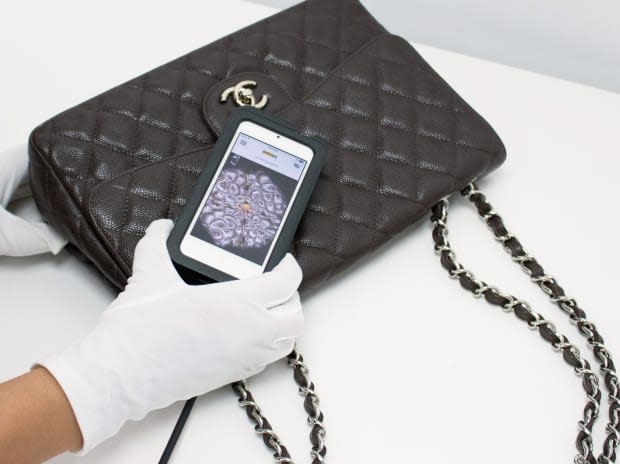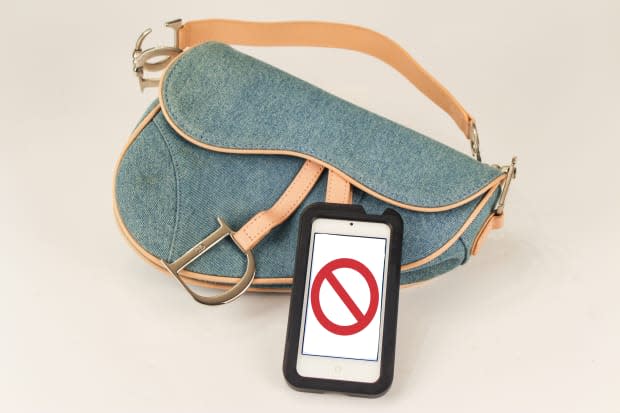Can Technology Keep Fake Handbags Out of the Marketplace?
Entrupy, which works with hundreds of secondhand and full-price retailers to identify counterfeits through an app, certainly thinks so.

It's difficult to remember a time when Ebay and brick-and-mortar stores were the only places you could buy designer handbags secondhand, before now-huge marketplaces like The RealReal and Rebag launched to disrupt the whole process. Aside from convenience and navigability, the biggest advantage these modern retailers offer (or claim to) is authenticity. They boast of their highly trained authentication experts; but with the proliferation of "superfakes" — counterfeit bags so high in quality that they look real even to professionals — it's increasingly possible for knockoffs to slip through the cracks. Shoppers have reported as much, and Chanel even sued The RealReal, claiming only the brand itself could confirm the authenticity of its products. It's even possible for an authentic bag to be deemed inauthentic, and for customers to unwittingly purchase fakes from even the most seemingly trustworthy sources.
This is where the founders of Entrupy saw an opportunity — to remove human error from the equation, and accommodate a wide range of businesses — by automating authentication through machine learning and AI. The company started in 2012 and spent its first four years just collecting data from all over the world, which largely involved buying a lot of luxury designer handbags — both real and fake. "We spent a substantial amount of money on the best counterfeits and then also buying from the brands," explains Deanna Thompson, Entrupy's director of business. Today, the company has over 100,000 real and fake bags, total. The more data it collected, the smarter the algorithms became; in 2016 Entrupy devices were made available to secondhand retailers across the country. It has over 400 online and brick-and-mortar retailers on board in addition to other clients that include law enforcement and customs agents. "Now, we don't have to really go out and seek the data. It's coming to us because every time somebody uses the device, the algorithms get smarter," says Thompson.
The device is literally an iPod or iPhone set up with the Entrupy app and held inside a Mophie-like gadget. The app walks you through the authentication process, which involves taking a few photos of the inside and outside of the item, and results are given in real time once the algorithms analyze the materials in the photos. The company claims the technology can achieve results with a 99.1% accuracy.
Related Articles
2018 Was the Year Resale Went Mainstream
Counterfeit Handbags Are Getting Harder and Harder to Spot
Here's How to Make a Living Off Resale Sites
Entrupy has intentionally flown relatively under the radar, and doesn't disclose most of the retailers it works with, with the exception of Goodwill, with which it has a nationwide partnership, and one other which we'll get into below. But Thompson is confident it will grow quickly, simply because of the convenience and confidence it offers retailers. "This is a game changer,” she says. "Not only is it freeing up your time, but it's also removing the liability from the store owner and it's standing behind you and it's creating trust within the marketplace."
On Thursday, Entrupy released a State of the Fake report, analyzing data from all of the authentications it performed last year — $50 million of merchandise, to be exact. It shows that the majority of fakes (or "unidentified" items, as the company calls them) Entrupy identified were "very good" to "super-fake" quality, and that the the percentage of items deemed authentic grew from 85% to 90% between 2017 and 2018. It points to potential reasons for that, including sellers being more careful and vigilant about verification, and more afraid of getting caught as authentication efforts advance.
It also sheds a light on what drives trends in the counterfeit handbag world: Louis Vuitton is among the most-faked brands because its styles, materials and monogram don't change as frequently as others. Because Chloé bags are so difficult to authenticate by eye, an alternative solution like Entrupy is more desirable. Higher demand for certain bags often translates into higher quantities of counterfeits, too: Hermès and Goyard had the highest percentages of "unidentified" bags because they're highly desired and deliberately produced in limited quantities. Gucci fakes have grown increasingly popular simply due to the popularity of the brand. Resale value can also have an impact on the popularity of counterfeiting certain styles.

Counterfeit bags don't only enter the supply chain through secondhand retailers, either. They can come through illegitimate websites where customers may believe they're getting a good deal on the real thing, only to be sent a fake. They can also come in the form of fraudulent returns at full-price stores. Entrupy's next goal is to move into the primary market with a new product called Fingerprinting: Basically, a brand or retailer photographs part of a new bag at any point in the supply chain before it's merchandised and sold to a customer. Then, if a customer returns that bag, they take the same photo to ensure it's a match to a bag the retailer sold.
Last month, Entrupy unveiled a partnership with UK department store chain Selfridges, which recently found that people were purchasing authentic goods and then returning fake versions for full refunds. For a retailer of Selfridges's scale, employing an easy-to-use device is more realistic than training every sales associate in the nuances of luxury authentication, and makes the process quicker for the customer, who may be making a legitimate return. A verdict on whether it is the same item can come through in just seconds. During a trial, the device found 11 out of 109 returns to be potentially fraudulent.
As evidenced by its State of the Fake report, Entrupy is on a mission to shed more light on the world's counterfeiting problem — from the thousands to millions of dollars it can cost brands and retailers, to the social, environmental and health risks (and perhaps make a bigger name for itself in the process).
"There's no regulation, so when you think about who's making them, it's horrifying; you've got kids chained to tables, women locked in factories. The chemicals that are used in [producing these items] — there's no data as to what they can do to you," says Thompson.
Indeed, a recent Better Business Bureau report on counterfeiting, which covered not just fake handbags but a slew of other products from sneakers to toys to makeup, found that international organized crime groups are involved heavily in counterfeiting, and that at least some of the proceeds from counterfeits may be used to fund terrorist groups. It also cites a consumer guide issued by the International Trade Administration that estimated in 2016 that counterfeiting and piracy cost the U.S. economy, annually, between $200 billion and $250 billion, and 750,000 jobs.
"People think it's a victimless crime," Thompson adds. "It's just a lack of education."
Never miss the latest fashion industry news. Sign up for the Fashionista daily newsletter.
